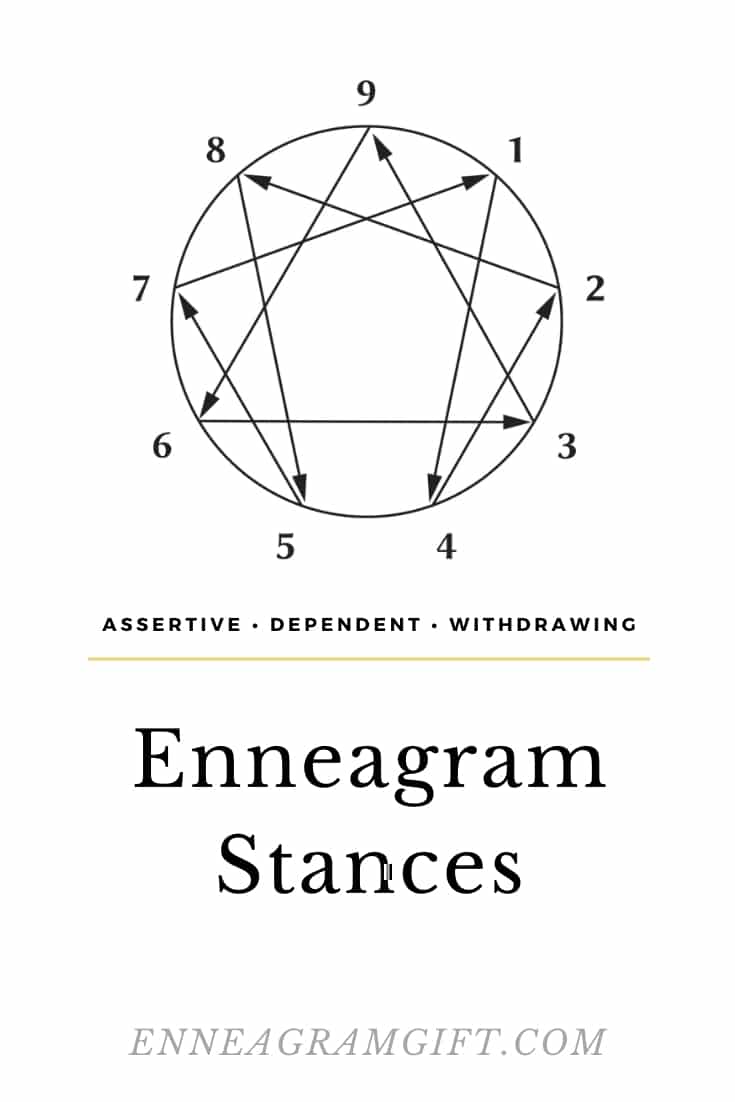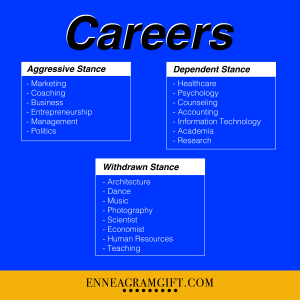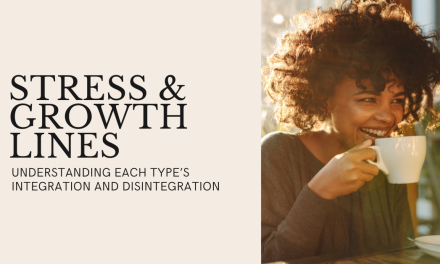Enneagram stances categorize people into three main categories based on how they interact with those around them. The Enneagram stance is a powerful tool for helping people understand themselves and others.
Three main stances influence how you interact with others: Aggressive, Dependent, and Withdrawn. Each of the three Enneagram stances refers to a person’s social style.
Understanding your Enneagram stance can forever impact how you see yourself and the world around you. This effect includes your career and social relationships too.
Below you’ll discover what Enneagram stances are, which stance each of the nine Enneagram types takes, and how each stance can impact you.
Enneagram Stances F.A.Q.’s
What Are Enneagram Stances
Each Enneagram stance is a strategy or method that helps us get what we want or achieve a goal. Each Enneagram type takes one of the three stances during social interactions. The three stances are the Aggressive stance, Dependant stance, and Withdrawing stance.
Once you understand each of the Enneagram types, you can begin to study the Enneagram stances. Each of the three Enneagram stances encompasses three Enneagram types. Each type will be referred to by its number (type 1) rather than by its full name (type 1: The Reformer).
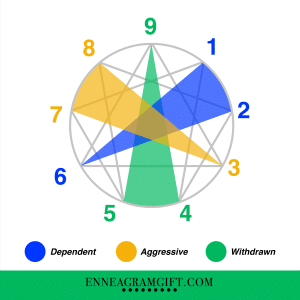
Each of the three Enneagram stances:
- Refers to your social style
- It helps answer the question: when we want something, how do we tend to act to get it?
We’ll cover each of the enneagram stances and how they influence social interaction.

Enneagram Stance One: The Aggressive Stance
Types Three, Seven, and Eight are part of the aggressive stance.
The Aggressive Enneagram Stance becomes bold and assertive to get what they desire or achieve a goal.
They also commonly exhibit the following attributes:
- High Energy
- Optimism
- Positivity
- Enthusiasm
- Goal-Oriented
- Focused
However, there can be downsides to these aggressive behaviors. They can become impulsive or take bold action too soon without thinking things through and considering the consequences.
This stance can also overshadow their ability to consider how their aggressiveness might be driving people away or negatively impacting the people around them.
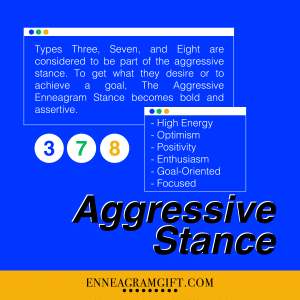
Type 3: The Achiever
Achievers are usually self-assured and confident in themselves and their abilities. This confidence they exude allows them to be a role model for others at their best. Their high levels of ambition can also drive them to the top of the ladder of success, either in their careers, social life, or other endeavors.
Type 7: The Enthusiast
Sevens take delight in the best possibilities around them and are optimists. They are excellent and reframing the world around them and turning positives into negatives. In other words, their strength is to “look at the bright side” and be happy most of the time.
Because of their tendency to always look at the bright side, enthusiasts sometimes get stuck in the trap of denial. This trait means that they minimize the adverse effects of a situation to a fault. So much so that they may pretend the negatives don’t exist or refuse to deal with them. In either case, this can lead to more significant and more complex problems later.
Type 8: The Challenger
Eights have strong and dominating personalities. They strive to use their strong personality to help their team succeed or inspire those around them. This aspect means eights often find themselves in leadership roles.
However, their strong personality can border on intimidation and altercations when taken too far. They tend not to back down from a conflict and do not like to be controlled by others. So, this can sometimes cause problems with cooperation and collaboration.
Enneagram Stance Two: The Dependent Stance
The dependent stance includes types one, two, and six.
The Dependent Enneagram Stance is less bold and assertive than the aggressive types and relies more on relationships to achieve what they want.
This relational aspect allows them to exhibit the following positive characteristics well:
- Reasoning to solve problems
- Coming up with creative solutions
- Considering the needs of others around them
- Fostering positive relationships
- Exhibiting care and empathy
On the downside, dependent stance types risk becoming self-sacrificial. They put aside too many of their desires to benefit the greater good. This weakness can result in not advocating for themselves or possibly becoming vulnerable to others taking advantage of them.
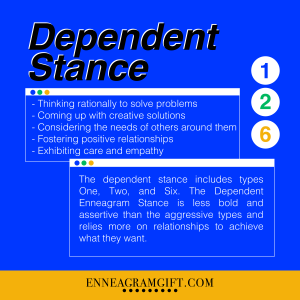
Type 1: The Reformer
The type one reformer is said to have a sense of mission to improve the world around them. Type Ones focus primarily on practical action and how they can most be helpful to others around them. In other words, they try to add value to situations through their knowledge and expertise. They also strive to overcome adversity and are considered very persistent.
Conversely, others may see reformers as somewhat too rigid or overly disciplined. This trait is because they do not often give in to their instincts. Instead, they let logic and reasoning lead when assessing a complex situation.
Type 2: The Helper
Type two people are considered very warm and empathetic to others. More than anything else, they want to love and be loved by others, and they tend to do so through expressing emotion. They are also very generous and give to others either in measures of time, money, or acts of service.
The downfall of the two is that when they cannot express their love and emotion for others, they can sometimes struggle with feelings of worthlessness. They seek validation through serving others, which can reach unhealthy levels if they become overdependent.
Type 6: The Loyalist
Sixes are best known for being persistent and hard-working. They tend to treat relationships the same way, as they are loyal and steadfast to their friends, families, and workplaces. They tend to stick with a project through to the end.
However, sixes have downsides as well. They can plan for the worst and have over-anxious feelings about doomsday scenarios that all go wrong around them. Because of their tendency for loyalty, they sometimes take it to a fault and hang on to relationships far longer than they should.
Enneagram Stance Three: The Withdrawn Stance
Finally, types four, five, and nine fall into the withdrawn category.
The Withdrawing Enneagram Stance best pursues goals and desires when they have the chance to be by themselves and away from others.
This behavior gives them a chance to think and plan in peace. Here are some of the withdrawn stance’s positive tendencies:
- Insightful
- Clever
- Curious
- Knowledgeable
- Smart
- Witty
- Self-Aware
Conversely, the withdrawn stance can sometimes struggle with connecting with others and social relationships. They may want others to notice them but are too reluctant and unengaged. Their need to withdraw can result in them becoming too self-reliant and not involved enough in their relationships.

Type 4: The Individualist
Individualists tend to be more quiet, withdrawn, and private. This is not to say that they don’t enjoy social relationships or close family bonds. Instead, they are at their best when given space to examine themselves and their minds thoughtfully. They generally do an excellent job of seeing themselves for who they are and being honest with themselves.
Type 5: The Investigator
Type fives are rather curious about themselves and the world around them. They most desire to gain and possess knowledge because it helps them feel worthwhile and valuable. They also tend to be strong critical thinkers who question the world around them when given questionable information.
The downside for fives is that feelings of inadequacy or insecurity sometimes fuel their quest for more knowledge. They thrive on always having something insightful to say, but these feelings of inadequacy and insecurity can exacerbate when they cannot do so.
Type 9: The Peacemaker
Nines are best known for their cooperativeness and tremendous ability to solve problems creatively and defuse conflicts. As the name suggests, they strive to maintain a peaceful environment and have strong interpersonal skills.
They want to experience little to no conflict in their daily lives, which can cause them to avoid difficult situations altogether. However, this need to keep the peace can sometimes become overly passive. Nines are at risk of going with the flow too much and not standing up for themselves when they should make their voice heard.
Enneagram Stances Affect How You View the World Around You
Your Enneagram type and Enneagram stance can influence how you see and interact with the world around you in various ways.
In terms of relationships, enneagram stances can affect how you manage daily social interactions and long-term, very close relationships between you and your family and friends.
Your Enneagram type and Enneagram stance can also affect your career. Understanding your type and stance can help you pick the right job because certain types thrive in specific career paths. It is also true that understanding your Enneagram can help you advance in your career.
How Enneagram Stances Affect Your Relationships
Enneagram stances affect how you see daily interactions with everyone, from coworkers and strangers to loved ones. Each Enneagram stance views these relationships slightly differently.
The Aggressive Stance Moves Against Others
For example, the aggressive stance will move against people to get what they want. They tend to seek attention from those around them for their accomplishments and try to gain autonomy by controlling their situation. Others sometimes interpret this behavior as abrasive and off-putting and can drive relationships away.
The Dependent Stance Moves Towards Others
The dependent stance focuses on drawing closer to others to get what they want and achieve goals. They generally thrive on being part of a group and collaborating with and relying on others. They also find comfort and approval in the group setting. Helping others is also crucial for dependent stance types.
On the other hand, this dependence on others can sometimes lead to over-dependence. Dependent types must set and adhere to proper boundaries to maintain healthy and fulfilling relationships.
The Withdrawn Stance Moves Away from Others
Notice the subtle difference here between the withdrawn stance and the aggressive stance. As the name suggests, the withdrawn stance moves away from conflict and all other forms of interaction. Moving away from others is not the same as moving against others.
Instead of relying on the help of others to get what they want, they look inward. They highly value self-authenticity and rely on their knowledge and inner strength to lead them to where they are trying to go.
This is not to say they cannot maintain friendships or close relationships. Instead, the withdrawn stance responds best when given time and space to think introspectively.
How Enneagram Stances Can Influence Your Career
Each Enneagram type matches up well with a few different careers based on their inherent personalities and tendencies. This is based on what the job requires and how it closely matches the strengths of each Enneagram stance and type. The following lists are not exhaustive. Instead, they are a few common suggestions for a career for those in each stance.
Careers for the Aggressive Stance
Because aggressive stance types are highly motivated, goal-oriented, and driven, they tend to make good leaders. Because they are not afraid to go after their ideas, their enthusiasm can be contagious and inspire those around them. Here are a few examples of career paths they may succeed in:
- Marketing
- Coaching
- Business
- Entrepreneurship
- Management
- Politics
For More Career Advice For Individuals In The Aggressive Stance, Click HERE
Careers for the Dependent Stance
The dependent stance is known for being precise and detail-oriented and wanting to be generous with their time and positively impact the world around them. They find success in jobs where they feel they can serve others. Here are a few examples:
- Healthcare
- Psychology
- Counseling
- Accounting
- Information Technology
- Academia
- Research
For More Career Advice For Individuals In The Dependent Stance, Click HERE
Careers for the Withdrawn Stance
Withdrawn stance types tend to be highly creative. They thrive in areas where they can let that creativity and ability to think introspectively run free. They constantly investigate the world around them and mull over their findings. Here are a few examples of promising careers for withdrawn stance types:
- Architecture
- Dance
- Music
- Photography
- Scientist
- Economist
- Human Resources
- Teaching
For More Career Advice For Individuals In The Withdrawing Stance, Click HERE
There Are Plenty of Career Exceptions For Every Enneagram Stance & Type
Just because you don’t see your career matching your Enneagram stance doesn’t mean you are in the wrong place. Again, this list is general suggestions and ideas, not concrete rules.
Moreover, it isn’t exhaustive, meaning there are plenty of other examples of careers that could fit each stance. Additionally, more than one stance can thrive in the same type of career. That is, both an aggressive type and a dependent type could succeed in a career in academia. For more job ideas for each enneagram type, check out this post HERE.
How Each Enneagram Stance Can Learn from Other Stances
Since each Enneagram stance has strengths and weaknesses, it stands to reason that they can each teach each other a thing or two about how to thrive in certain situations. Or, they might be able to help each other see the world a little differently and gain additional experience and perspectives.
Aggressive types might be able to teach the other two types how to be bolder and more assertive. It is the strength of the aggressive type to intensely chase after what they desire and not let up until they get there. This allows them to chase after goals with a focus and steadfastness that is highly sought after.
Dependent types can show others how to interact more cooperatively with those around them. They are best at building strong social networks and fostering a sense of community and interdependence wherever they go. This is what allows them to flourish in collaborative environments.
Finally, withdrawn types can show others how to be more introspective. To more closely examine how they fit into the world around them and consider their characteristics and personality traits more closely. They are at their best when given independent space to work and think.
Understanding the Three Enneagram Stances and How They Influence Your Interactions with Others
Now that you are familiar with the three Enneagram stances and the nine Enneagram types, you can better understand how your type affects your relationships and how you see the world.
This understanding is crucial in making the most of your relationships with your family and friends. It also can help you choose a career that is right for you.
If you want to further explore enneagram stances and your type by taking a test, check our list of The Four Best Free Enneagram Tests Online.
For More Helpful Enneagram Resources & Blog Posts:
The Helpful Enneagram Guide To The System, 9 Types, & Tests
The 3 Enneagram Triads + Advice For Responding To Emotions
The 9 Best Enneagram Resources And Blog Posts
Enneagram Stances Sources:
https://tests.enneagraminstitute.com/
https://www.enneagraminstitute.com/type-descriptions
The Path Between Us: An Enneagram Journey to Healthy Relationships – Suzanne Stable
https://www.truity.com/blog/what-are-enneagram-stances-and-why-are-they-important

